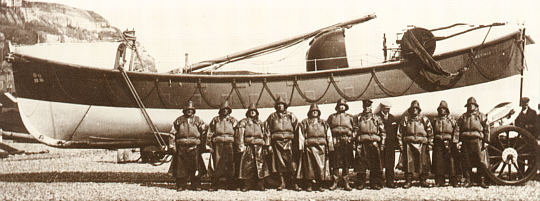Restoration and preservation is what the ownership of the Little Ships is all about. Every owner has a story to tell of how he or she found a vessel, researched her history, overcame seemingly insuperable difficulties and made great personal sacrifices to save a ship which was well past her natural life span, because her historic achievements deserved it. But the story doesn't end there. Owners grow old, or run out of cash. Little ships, though saved and restored, can quickly deteriorate again unless the work continues year after year. Otherwise they find themselves on the danger list again. Some of those who were shown in The Little Ships of Dunkirk, restored and in fine shape are nearly derelict now. Unless a new owner can be found with the time and means to shoulder the burden they can be lost.
The Dunkirk Little Ships Restoration Trust was founded in 1993 as a registered charity to save Little Ships in danger of destruction, to encourage the skills of traditional boatbuilding and conservation, to raise funds for this work and to find dedicated new owners for ships saved by the Trust. In its first two years the Trust has helped six Little Ships to survive and has recruited well over a hundred active members who have given not only money, but valuable time and skills to this vital work.
The Trusts
first vessel was the RNLI Lifeboat Cyril &
Lilian Bishop.

She is shown and described in The Little Ships of Dunkirk,
called Lindy Lou, already deteriorating in Askaig harbour, on the West Coast of
Scotland. The RNLI Historic Society reported that she was likely to be lost and
her owner was too ill to save her. By a combination of ingenuity and generosity
by the Trust, members of the ADLS, the Royal Navy and the Army, the old Lifeboat
was moved by crane, landing craft and truck from Scotland to Southampton. The
inevitable disasters encountered included groundings due to neap tides, fouled
propellers and breakdowns, but Cyril & Lilian Bishop arrived at Southampton and
then another saviour appeared in the shape of Simon Evans, the British
boatbuilder/Lifeboat-enthusiast in France, Graham Beal of Thanet Boat
Transport, who runs a regular service to France, took the old Lifeboat to
Simon's yard and he has already started her on the road to recovery.
The aptly
named
Challenge was the last steam tug to serve on the
Thames and was based on the river all her working life. At the time of Dunkirk
she was naturally called to help in Operation Dynamo, towing some of the Little
Ships across the Channel to save fuel and herself rescuing some of the 385 000
troops from the advancing German army. By 1993 she had deteriorated badly and
would have been scrapped but for the intervention of the Trust. Thanks to the
generosity of Sun Tugs, whose name earned great distinction at Dunkirk, and the
Port of Tilbury, Challenge was moved to Tilbury Docks where a team of volunteers
led by Ian MacDougal has put in more than a thousand man- and woman-hours to
restore her. The volunteers include a team of Duke of Edinburgh's Award
qualifiers, meeting the second objective of the Trust, which is to promote the
skills necessary for re-building and preserving old craft. Everyone concerned
felt the thrill of hearing the steam boilers of Challenge turning her engines
once more. Now it is planned for her to become a living memorial to the age of
steam and the history of Dunkirk, a suitable site is currently being sort for
her.
In all, twelve have been saved from the chainsaw. Six are now in new ownership; two of them are now fully restored. Three are undergoing restoration now and three remain in the care of the Trust. Numerous others have been offered to the Trust but they were too seriously degraded to restore
Inevitably it is an expensive process to save and then restore historic objects and the trust is always in need of finance. You can help maintain the Trustsí impetus in saving Little Ships at risk by becoming a member or making a donation. Please go to the Contact us page for more details.